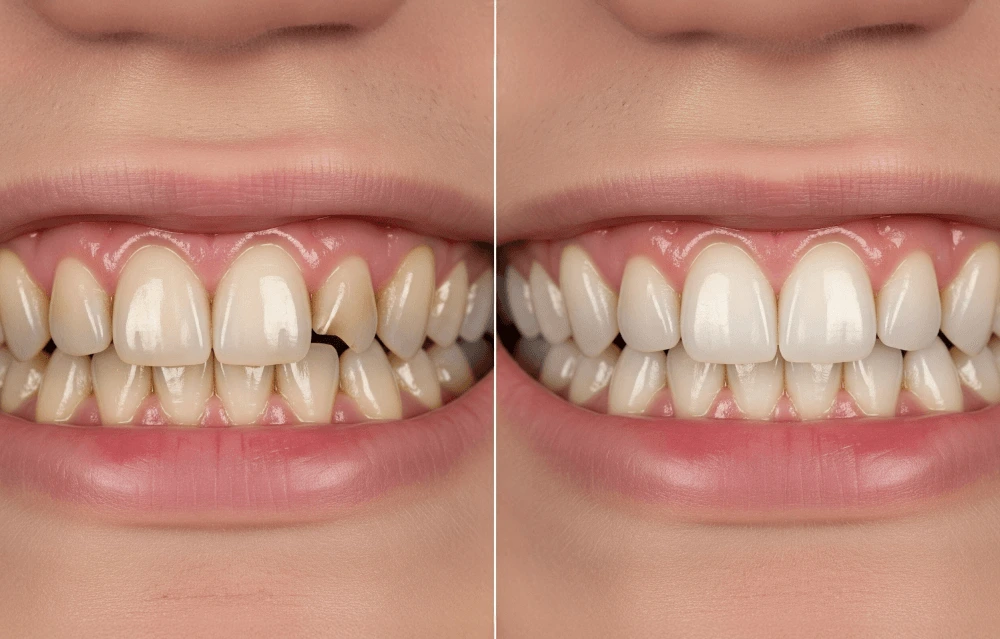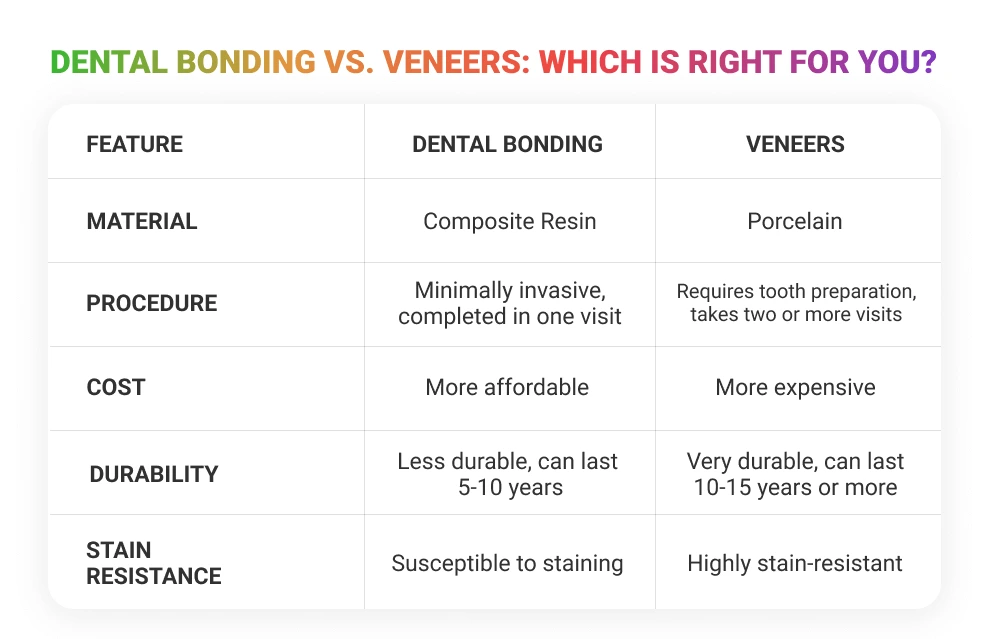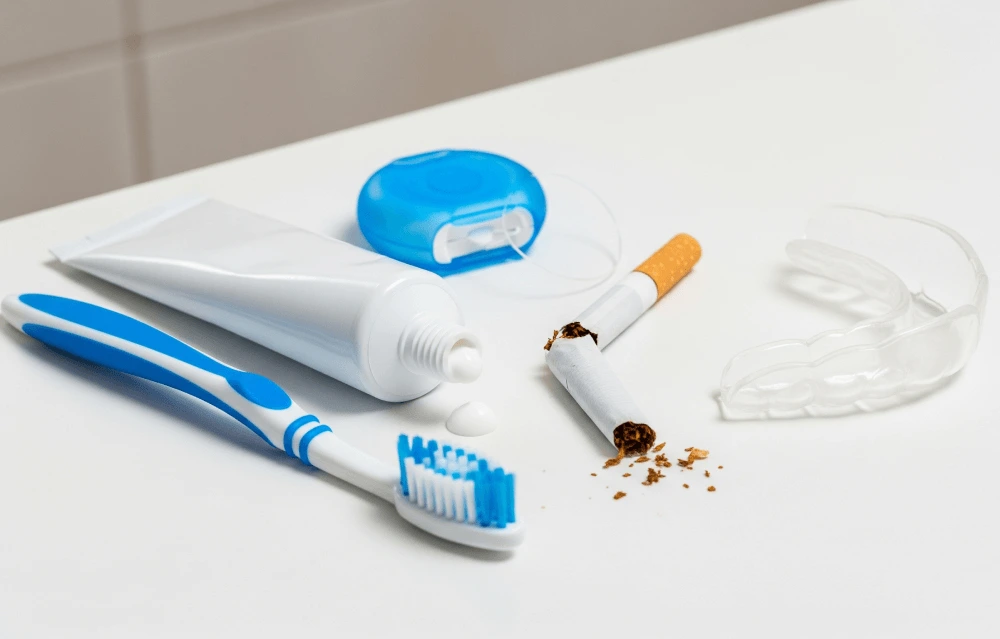Cosmetic Dental Bonding: How Much Is It & How Long Does It Last?
1 Nov 2025
Everyone deserves a smile they can be proud of. But what if minor imperfections, such as chips, cracks, or gaps, are holding you back?
You might think that achieving a flawless smile requires expensive and invasive procedures, but that’s not always the case.
There’s a simple, affordable, and effective solution that can transform your smile in just one visit: cosmetic dental bonding.
At Greenspoint Dental, understanding your options is the first step towards achieving the smile of your dreams.
In this comprehensive guide, we’ll explore everything you need to know about cosmetic dental bonding, from the cost and longevity to the procedure itself.
What is Cosmetic Dental Bonding?

Cosmetic dental bonding is a procedure where a tooth-colored composite resin is applied to a tooth, sculpted into shape, hardened, and polished. It’s a versatile treatment that can be used to correct a variety of cosmetic dental issues, including:
- Chipped or cracked teeth
- Gaps between teeth
- Tooth discoloration
- Short or misshapen teeth
- Exposed tooth roots due to gum recession
Think of it as a dental art form. Your dentist acts as a sculptor, using the composite resin to meticulously craft a seamless and natural-looking restoration that enhances your smile.
The Dental Bonding Procedure: A Step-by-Step Guide
One of the greatest advantages of cosmetic dental bonding is that it’s a quick and minimally invasive procedure that can typically be completed in a single office visit. Here’s what you can expect:
- Consultation and Shade Selection: The first step is a consultation with your dentist to determine if you’re a good candidate for dental bonding. If you are, your dentist will use a shade guide to select a composite resin color that perfectly matches your natural teeth.
- Preparation: Unlike more invasive procedures like veneers or crowns, dental bonding requires minimal tooth preparation. In most cases, anesthesia is not even necessary. Your dentist will gently roughen the surface of the tooth and apply a conditioning liquid to help the bonding material adhere.
- Application and Sculpting: Next, your dentist will apply the tooth-colored resin to your tooth. They will carefully mold and sculpt the resin to the desired shape, correcting any imperfections.
- Curing: Once the resin is perfectly shaped, a special ultraviolet light is used to harden, or “cure,” the material. This process takes only a few seconds.
- Polishing: After the resin has hardened, your dentist will further trim, shape, and polish it to match the sheen of the rest of your teeth. The end result is a smooth, natural-looking restoration that blends seamlessly with your smile.
The entire procedure typically takes between 30 to 60 minutes per tooth.
How Much Does Cosmetic Dental Bonding Cost?
The cost of cosmetic dental bonding can vary depending on several factors, including the extent of the procedure, the number of teeth being treated, the dentist’s experience, and your geographic location. On average, you can expect to pay between $300 and $600 per tooth.
It’s important to note that dental bonding is often considered a cosmetic procedure, so it may not be covered by dental insurance.
However, if the bonding is being used to repair a chipped or decayed tooth, your insurance provider may cover a portion of the cost. Be sure to check with your provider to understand your coverage.
When compared to other cosmetic dental treatments like veneers or crowns, dental bonding is a much more affordable option.
This makes it an excellent choice for patients who are looking for a budget-friendly way to enhance their smile.
How Long Does Dental Bonding Last?
With proper care, cosmetic dental bonding can last for 5 to 10 years. The longevity of your dental bonding will depend on several factors, including:
The location of the bonding: Bonding on front teeth, which experience less biting pressure, tends to last longer than bonding on molars.
Your oral habits: Habits like biting your fingernails, chewing on pens, or using your teeth to open packages can damage the bonding material.
Your diet: Consuming hard or sticky foods can also put stress on the bonding and cause it to chip or break.
Your oral hygiene routine: A consistent and thorough oral hygiene routine is essential for maintaining the health and longevity of your bonded teeth.
Pros and Cons of Cosmetic Dental Bonding
Like any dental procedure, dental bonding has its own set of advantages and disadvantages.
Pros:
- Affordable: Dental bonding is one of the most cost-effective cosmetic dental procedures available.
- Minimally Invasive: The procedure requires minimal tooth preparation, preserving the natural structure of your teeth.
- Quick and Convenient: In most cases, dental bonding can be completed in a single office visit.
- Painless: Anesthesia is typically not required for dental bonding, but we do offer sedation dentistry for patients who are nervous about the procedure.
- Aesthetically Pleasing: The composite resin can be matched to the exact shade of your natural teeth, creating a seamless and natural-looking result.
Cons:
- Susceptible to Staining: The composite resin used in dental bonding is not as stain-resistant as porcelain veneers or crowns. To prevent staining, it’s important to avoid or limit your consumption of staining foods and beverages like coffee, tea, and red wine.
- Less Durable: Dental bonding is not as strong or durable as other restorative options like veneers or crowns. It can be prone to chipping or breaking, especially if you have habits like teeth grinding or biting on hard objects.
- Not a Permanent Solution: While dental bonding can last for several years, it will eventually need to be repaired or replaced.
Dental Bonding vs. Veneers: Which is Right for You?
Dental bonding and veneers are both popular cosmetic dental treatments that can be used to improve the appearance of your smile. However, there are some key differences between the two.

Ultimately, the best choice for you will depend on your individual needs and goals.
If you have minor cosmetic imperfections and are looking for a quick, affordable, and minimally invasive solution, dental bonding may be the perfect choice.
If you have more significant cosmetic concerns and are looking for a long-lasting, durable, and stain-resistant solution, veneers may be a better option.
How to Care for Your Bonded Teeth

Caring for your bonded teeth is simple and doesn’t require any special products. Just follow these simple tips to keep your smile looking its best:
- Practice good oral hygiene: Brush your teeth at least twice a day with a soft-bristled toothbrush and fluoride toothpaste. Floss daily to remove plaque and food particles from between your teeth.
- Avoid staining foods and beverages: To prevent staining, limit your consumption of coffee, tea, red wine, and other staining foods and beverages.
- Don’t smoke: Smoking can cause the bonding material to yellow and become discolored.
- Avoid hard and sticky foods: Chewing on hard objects like ice or hard candy can chip or break the bonding material.
- Wear a mouthguard: If you play sports or grind your teeth at night, wearing a mouthguard can help protect your bonded teeth from damage.
- Schedule regular dental checkups: Regular checkups and cleanings are essential for maintaining the health and longevity of your bonded teeth. Your dentist can check for any signs of wear and tear and make any necessary repairs.
The Takeaway
Cosmetic dental bonding is a fantastic option for anyone who wants to improve their smile without breaking the bank. It’s a quick, painless, and minimally invasive procedure that can correct a variety of cosmetic imperfections.
If you’re ready to take the first step towards a more confident smile, we encourage you to schedule a consultation to discuss whether cosmetic dental bonding is right for you.
A beautiful smile is within your reach, and we’re here to help you achieve it.
Related Blog Articles